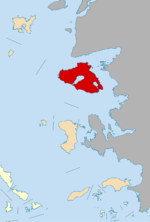|
Greek city of Mytilene on the island of Lesbos
Bronze 9mm (0.58 grams) Struck circa 440-350 B.C.
Reference: Sear 4270 var.; HGC 6, 1057 var.; BMC Troas, p. 184, no.5 var.
Laureate head of Apollo right.
MYTI, Bull’s head right.
Lesbos was the largest of the islands off the coast of western Asia Minor, Lesbos lay at the entrance to the gulf of Adramytteion. It was a great cultural center, and its mild climate and fertile soil supported no less than five cities, the most important of which was Mytilene. The chief city of Lesbos, Mytilene was situated in the south-east of the island, opposite the mainland. There can be little doubt that Mytilene was the mint of the important electrum coinage of Lesbos in the 5th and 4th centuries.
You are bidding on the exact item pictured, provided with a Certificate of Authenticity and Lifetime Guarantee of Authenticity.
Mytilene (Greek: Μυτιλήνη) is the capital city of Lesbos, a Greek island in the Aegean Sea, and capital of Lesbos Prefecture and the Northern Aegean region. It is built on the southeast edge of the island. Mytilene, whose name is pre-Greek, is also the seat of a metropolitan bishop of the Orthodox church.
As an ancient city, lying off the east coast, Mytilene was initially confined to an island that later was joined to Lesbos, creating a north and south harbour. Mytilene contested successfully with Methymna in the north of the island for the leadership of the island in the seventh century BC and became the centre of the island’s prosperous hinterland. Her most famous citizens were the poets Sappho and Alcaeus and the statesman Pittacus (one of the Seven Sages of ancient Greece). The city was famed for its great output of electrum coins struck from the late 6th through mid 4th centuries BC. Mytilene revolted against Athens in 428 BC but was overcome by an Athenian expeditionary force. The Athenian public assembly voted to massacre all the men of the city and to sell the women and children into slavery but changed its mind the next day. A fast trireme sailed the 186 nautical miles in less than a day and brought the decision to cancel the massacre.
Aristotle lived on Mytilene for two years, 337-335 BC, with his friend and successor, Theophrastus after becoming the tutor to Alexander, son of King Philip II of Macedon.
The Romans, among whom was a young Julius Caesar, successfully besieged Mytilene in 80 B.C. Although Mytilene supported the losing side in most of the great wars of the first century BC her statesmen succeeded in convincing Rome of her support of the new ruler of the Mediterranean and the city flourished in Roman times.
In AD 56 Paul the Apostle stopped there on the return trip of his third missionary journey (Acts 20:14).
Lesbos, sometimes referred to as Mytilini after its capital, is a Greek island located in the northeastern Aegean Sea. It has an area of 1,632 square kilometres (630 sq mi) with 320 kilometres (199 miles) of coastline, making it the third largest Greek island. It is separated from Turkey by the narrow Mytilini Strait and in late Palaeolithic/Mesolithic times was joined to the Anatolian mainland before the end of the last Ice Age.
Lesbos is a separate regional unit of the North Aegean region, and is one of five governing islands within it. The others are Chios, Ikaria, Lemnos, and Samos. The total number of islands governed by the North Aegean are nine: Lesbos, Chios, Psara, Oinousses, Ikaria, Fournoi Korseon, Lemnos, Agios Efstratios and Samos. The capital of the North Aegean Region is Mytilene. The population of Lesbos is approximately 86,000, a third of whom live in its capital, Mytilene, in the southeastern part of the island. The remaining population is distributed in small towns and villages. The largest are Plomari, Kalloni, the Gera Villages, Agiassos, Eresos, and Molyvos (the ancient Mythimna).

Lesbos within the North Aegean
According to later Greek writers Mytilene was founded in the 11th century BC by the family Penthilidae, who arrived from Thessaly, and ruled the city-state until a popular revolt (590-580 BC) led by Pittacus of Mytilene ended their rule. In fact the archaeological and linguistic record may indicate a late Iron Age arrival of Greek settlers although references in Late Bronze Age Hittite archives indicate a likely Greek presence then. The name Mytilene itself seems to be of Hittite origin. According to Homer’s Iliad, however, Lesbos was part of the kingdom of Priam in what is now Turkey. Much work remains to be done to determine just what was happening and when. In Middle Ages, it was under Byzantine and then Genoese rule. Lesbos was conquered by the Ottoman Empire in 1462. The Ottomans then ruled the island until the First Balkan War in 1912, when it became part of the Kingdom of Greece.
|











